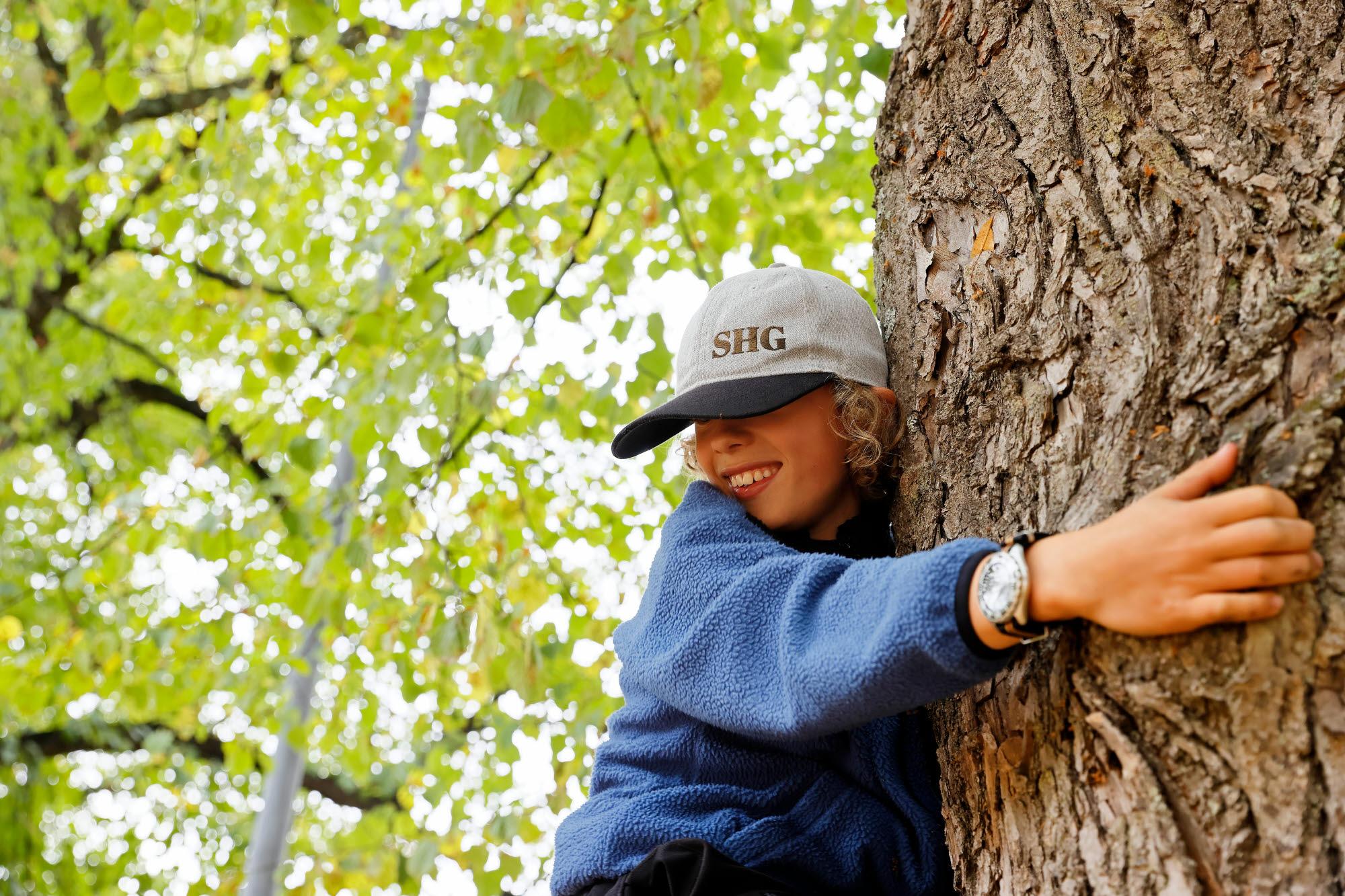
Nature Exposure and Children’s Health and Wellbeing
Our research
Nature exposure has shown favourable associations with children's health and development.
Visiting nature can provide an opportunity for families to be physically active and relieve stress in an affordable way.
Even though there is scientifically proven evidence of the benefits of nature exposure, research exploring the associations between nature visits and the wellbeing of young children is still limited. Research focusing on young children is important as nature experiences in childhood may predict nature exposure later in life.
The main research questions in Naturkraft concern whether sociodemographic and mental health factors are related to nature visits among families with preschool- and school-aged children, and whether frequent visits to nature are related to children’s physical activity, other health behaviors, wellbeing, and nature connectedness.
The project focuses on families with children aged 2–12 years and uses data from the DAGIS studies conducted in 2015–2016, 2017–2018, and 2023–2024. Data were derived from questionnaires completed by parents and schoolchildren, as well as from accelerometers worn by children during a one-week study period. The project also includes data from a web-based questionnaire completed by parents in a study conducted in a collaboration project with Folkhälsans Förbund’s Naturkraft-project in spring 2019. The Naturkraft research project began in autumn 2020 and is still ongoing.
Publications
Relationship between parent–child nature visits and children's connection to nature
Associations between parent–child outdoor visits and preschool-aged children’s screen time: a cross-sectional study
Launistola H, Lehto R, Engberg E, Björkqvist J, Rahkola J, Simonsen N, Wackström N, Tilli E, Roos E, Ray C. Journal of Activity, Sedentary and Sleep Behaviors. 2025.
Children’s decreasing time spent outdoors and increasing time spent on screen devices raise concern, as both can have negative impacts on children’s health. However, little is known about how context-specific outdoor time is associated with screen time among young children. This study examined the associations between parent–child outdoor visit frequency in nature, own yard, playground, and overall, and preschoolers’ screen time separately for weekdays, weekends and the whole week in total. Data were collected in the DAGIS intervention study’s baseline measurements in 2017 in Finland. In total, 673 parents of preschool children (3–6 years) provided data on parent–child outdoor visit frequency assessed with a survey, and children’s screen time assessed with a 7-day screen time diary. Linear regression analyses adjusted for child age, sex, socioeconomic background, and season, were conducted. The findings showed that more frequent parent–child visits to nature and own yard were associated with less child screen time on weekdays, while more frequent visits to playground were associated with less screen time on weekends. Additionally, visiting both nature, own yard, and playground more frequently was associated with less screen time during the whole week. Furthermore, higher parent–child total outdoor visit frequency was associated with less screen time on both weekdays, weekends and during the whole week. In conclusion, despite modest effect sizes, visiting diverse outdoor spaces could provide an alternative for young children’s screen use – differentially across weekdays and weekends. To support this, municipalities should ensure the availability of various types of outdoor spaces in neighborhoods.
Adult-child nature visits associate with 2–7-year-old children's Nature Connectedness.
Kokkonen J, Engberg E, Simonsen N, Wackström N, Ray J, Ray C.
Ecopsychology. 2023.
The connection that children have with nature appears to be weakening, which is a concern because nature connection is associated with children’s environmentally friendly behavior as well as with their health and well-being. However, the relationship between family nature visits and young children’s connection to nature is a fairly unexplored topic. Therefore, the aim of this study was to investigate the association between the frequency of adult–child nature visits and 2- to 7-year-old children’s nature connectedness (NC) using cross-sectional survey data from the Finnish project titled Naturkraft (Empowered by nature). We also examined whether socioeconomic and sociodemographic factors moderated the associations. The questionnaire respondents were parents, mainly mothers, (n = 1463) of children aged 2–7 years. Multinomial logistic regression analyses and moderator analyses were conducted. The results based on the parent-reported questionnaire revealed that when children visited nature with an adult in the family once a week or more, their overall NC was greater, they more likely derived greater enjoyment from nature and displayed stronger sense of responsibility toward nature than children who had a lower frequency of adult– child nature visits. Some of the associations were moderated by child’s gender and the region of residence. The results highlight the importance of frequent family nature visits during early childhood, as this can contribute to raising environmentally responsible children who enjoy and value nature.
Associations between parent–child nature visits and sleep, physical activity, and weight status
Associations between Parent–Child Nature Visits and Sleep, Physical Activity and Weight Status among Finnish 3–6-Year-Olds.
Kokkonen J-M, Vepsäläinen H, Abdollahi A, Paasio H, Ranta S, Erkkola M, Roos E, Ray C. International Journal of Environmental Research and Public Health. 2021.
Abstract: Nature visits and nature exposure have been shown to be favorably associated with children’s health and development, but the research regarding their associations with children’s lifestyle habits is limited. The current study aimed to investigate the associations between the frequency of parent–child nature visits and sleep, moderate-to-vigorous physical activity (MVPA) and weight status among three- to six-year-old Finnish preschoolers. Parents and their children (n = 864) participated in a cross-sectional DAGIS (increased health and wellbeing in preschools) study, which was conducted between 2015 and 2016 in Finland. In total, 798 parents answered a questionnaire on the frequency of parent–child nature visits, which also included questions on sociodemographic factors and their children’s sleep habits. Parents also reported children’s bedtimes and wake-up times and children wore an accelerometer for seven days. Trained researchers measured children’s weight and height. Linear and logistic regression analyses were conducted. More frequent parent–child nature visits were associated with children’s longer sleep duration at night, higher amounts of MVPA outside preschool time and, among girls, good sleep consistency. The frequency of parent–child nature visits was not significantly associated with whether children were overweight or obese or not. Promoting parent–child nature visits could be a cost-effective way to increase young children’s MVPA and enhance night-time sleep.
Association of sociodemographic factors with the frequency of adult–child nature visits
Sosiodemografisten tekijöiden yhteys lapsiperheiden luonnossa liikkumiseen. (Association of sociodemographic factors with the frequency of adult-child nature visits.)
Kokkonen J-M, Gustafsson J, Paasio H, Wiklund-Engblom A, Törnwall N, Erkkola M, Roos E, Ray C. Liikunta & Tiede 58 (5), 109–118.
Abstrakti: Luontoympäristö ja luonnon virkistyskäyttö ovat yhteydessä lukuisiin terveyshyötyihin lapsilla ja aikuisilla. Lapsuuden luontokokemukset ovat tärkeitä, sillä ne tukevat luonnossa liikkumista myös aikuisena. Perheen sosiodemografisten tekijöiden on havaittu olevan yhteydessä luonnossa liikkumiseen, mutta tulokset ovat olleet ristiriitaisia. Tämän tutkimuksen tarkoituksena on tutkia sosiodemografisten tekijöiden yhteyttä perheen aikuisten ja lasten säännölliseen yhdessä luonnossa liikkumiseen. Tutkimuksessa oli käytössä kolme aineistoa: DAGIS-kartoitusvaiheen kysely (n = 864), joka on kerätty vuosina 2015– 2016, DAGIS-intervention alkuvaiheen kysely (n = 728), joka on kerätty vuosina 2017–2018 ja Naturkraft (Luonnosta voimaa perheille) -hankkeen kysely (n = 1463), joka on kerätty vuonna 2019. Kyselyihin vastasivat 2–7-vuotiaiden lasten vanhemmat. Aikuisen ja lapsen yhdessä luonnossa liikkumista tarkasteltiin kahdessa ryhmässä 1) vähintään kerran viikossa yhdessä luonnossa liikkuvat ja 2) vähintään kolme kertaa viikossa yhdessä luonnossa liikkuvat. Aineistoja analysoitiin logistisella regressioanalyysilla. Tilastollisesti merkitseviä yhteyksiä tarkasteltaessa yhtä aikaa, keskeisimmät tulokset osoittivat, että nuoremmat lapset, vanhemman matalampi koulutustaso, äidin poissaolo työelämästä, paremmaksi koettu subjektiivinen toimeentulo ja kahden aikuisen kanssa asuminen olivat yhteydessä säännöllisempään perheen aikuisen ja lapsen yhdessä luonnossa liikkumiseen. Jatkossa olisi hyvä tutkia myös sosiodemografisten tekijöiden keskinäisiä yhteyksiä suhteessa säännöllisempään yhdessä luonnossa liikkumiseen. Tutkimuksemme tulokset osoittavat, että sosiodemografiset tekijät olisi syytä ottaa huomioon lapsiperheiden luonnossa liikkumista edistäviä hankkeita suunniteltaessa.
Parental mental well-being and the frequency of adult–child nature visits
Parental Mental Well-Being and Frequency of Adult-Child Nature Visits: The Mediating Roles of Parents’ Perceived Barriers.
Gustafsson J, Ojala A, Hiltunen P, Engberg E, Wiklund-Engblom A, Törnwall N, Roos E, Ray C. International Journal of Environmental Research and Public Health. 2021.
Regular access to green space has been shown to provide several health benefits for children. However, children today spend less time outdoors. Thus, it has become important to understand what drives and limits children’s activities in nature. Based on a Finnish online survey of 1463 parents of children aged 2–7 conducted in 2019, the current study examined parents’ perceived barriers to visiting nature with their children. It also examined how parental mental well-being is related to families’ frequency of nature visits, and whether this association is mediated by different categories of parents’ perceived barriers. Eleven out of 12 barriers were largely perceived by parents as reasons that did not prevent them from visiting nature with their children. Next, factor analysis indicated a three-factor solution to the barriers. The results of a multiple mediation analysis showed that better parental mental well-being was associated with more frequent adult-child nature visits, and this relationship was partially mediated by a “lack of competence and logistics” and a “lack of time and interest”, but not by “insecurity and fear”. The results indicated that parents with poor mental well-being were more likely to perceive barriers to visiting nature, which in turn appeared to be related to a higher likelihood of having children who visited nature less frequently.
- A literature review was conducted for the Naturkraft research project in order to identify what is already known about green exercise and its benefits for children. Literature Review for Naturkraft-project (PDF).
- The research project has continuously collaborated with the health promoting project Naturkraft. Research and results have been implemented into the health promoting project Naturkraft. A presentation in November 2021 gives an overall view of the research project results so far, and it is presented here.
- The research project has been a part of the needs assessment for the health promotion project. The process of the health promotion project was presented at the International Congress on Salutogenesis, Girona, Spain 17-18.6.2021. The presentation can be viewed here.
- The results from the Naturkraft research project were presented at Ulos–Ut– Out – Outdoor learning conference in Finland in June 15th–17th 2021.
Kort om studien på svenska
Forskningsprojektet Naturkraft fokuserar på naturvistelse och dess positiva effekter på barns hälsa och välbefinnande, till exempel undersöker vi samband till fysisk aktivitet och sömn.
Read more
Group Leader
Carola Ray
Doctoral Researcher
Henna Launistola
Adult-child nature visits associate with 2–7-year-old children's Nature Connectedness.
Kokkonen J, Engberg E, Simonsen N, Wackström N, Ray J, Ray C. Ecopsychology. 2023.
Associations between Parent–Child Nature Visits and Sleep, Physical Activity and Weight Status among Finnish 3–6-Year-Olds.
Kokkonen J-M, Vepsäläinen H, Abdollahi A, Paasio H, Ranta S, Erkkola M, Roos E, Ray C. International Journal of Environmental Research and Public Health. 2021.
Sosiodemografisten tekijöiden yhteys lapsiperheiden luonnossa liikkumiseen. (Association of sociodemographic factors with the frequency of adult-child nature visits.)
Kokkonen J-M, Gustafsson J, Paasio H, Wiklund-Engblom A, Törnwall N, Erkkola M, Roos E, Ray C. Liikunta & Tiede. 2021.
Parental Mental Well-Being and Frequency of Adult-Child Nature Visits: The Mediating Roles of Parents’ Perceived Barriers.
Gustafsson J, Ojala A, Hiltunen P, Engberg E, Wiklund-Engblom A, Törnwall N, Roos E, Ray C. International Journal of Environmental Research and Public Health. 2021.
Naturkraft project at Folkhälsans förbund
Signe and Ane Gyllenberg Foundation
Folkhälsan Research Center
Contact us

Henna Launistola
Doctoral Researcher
Public Health
